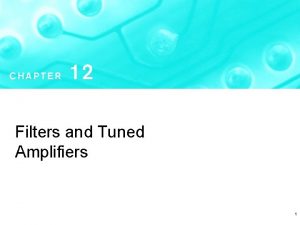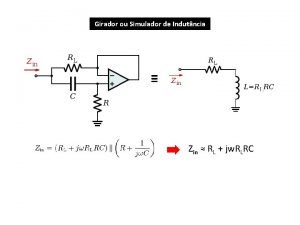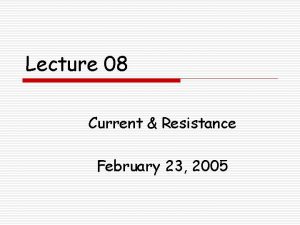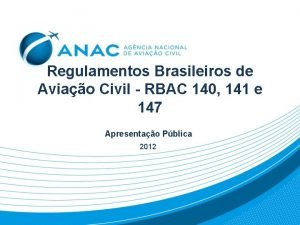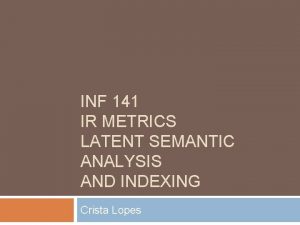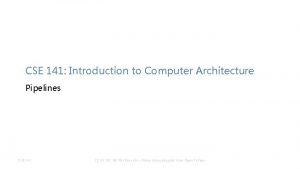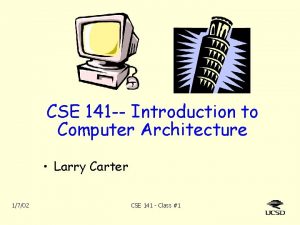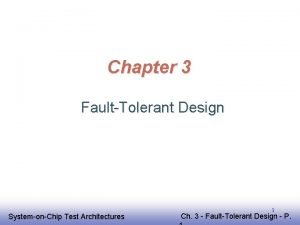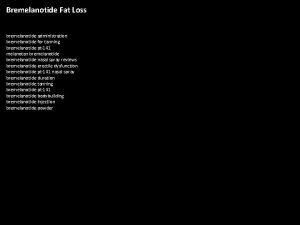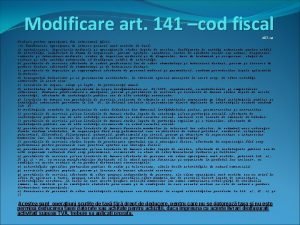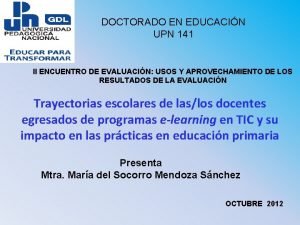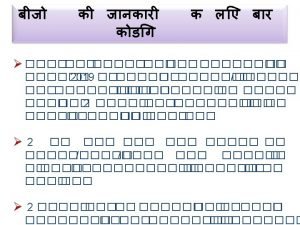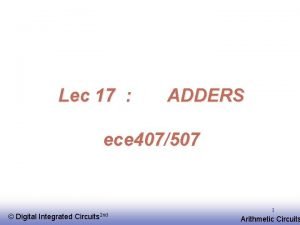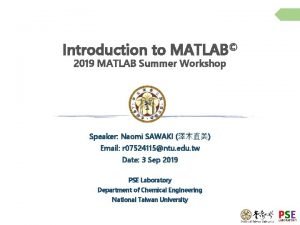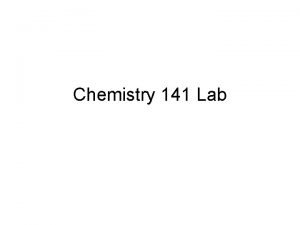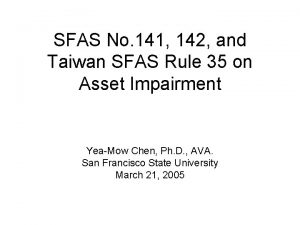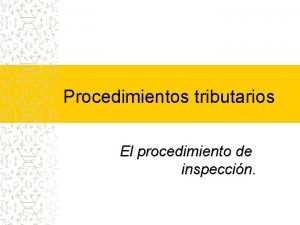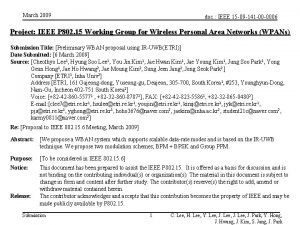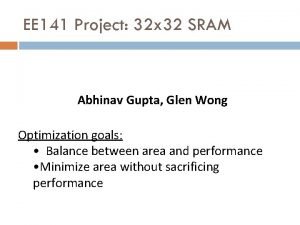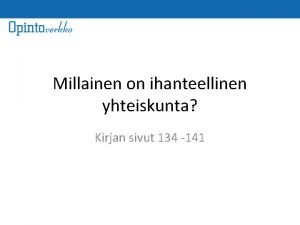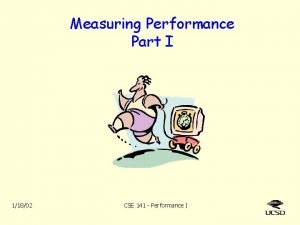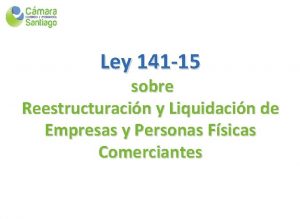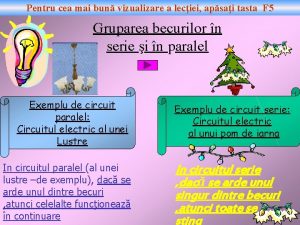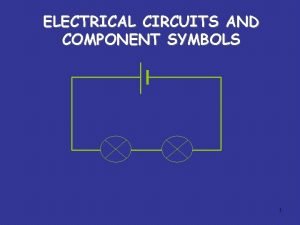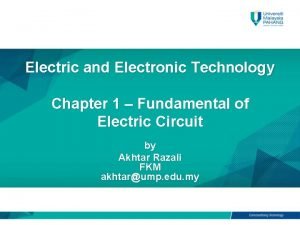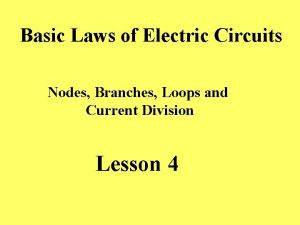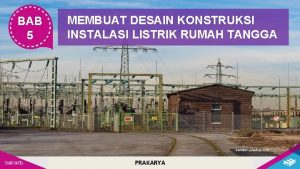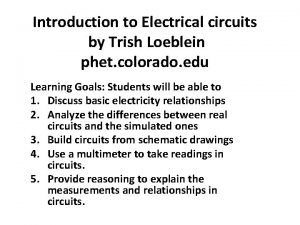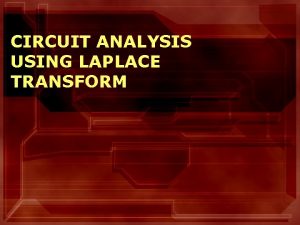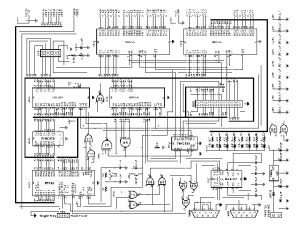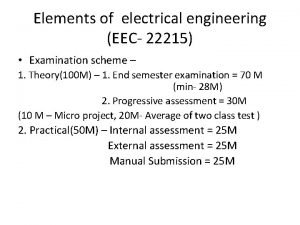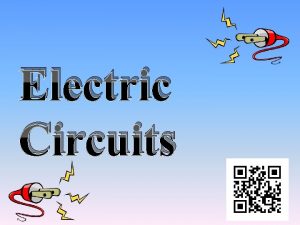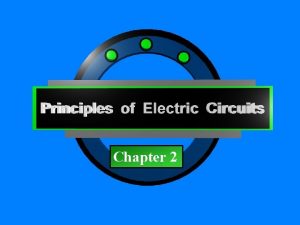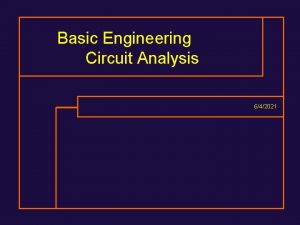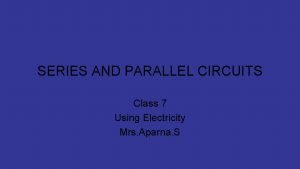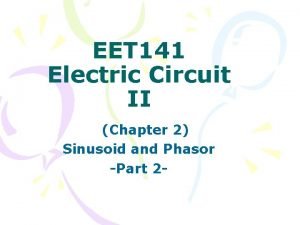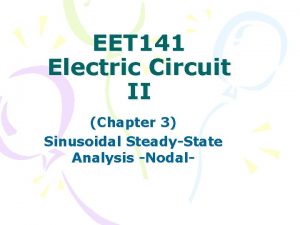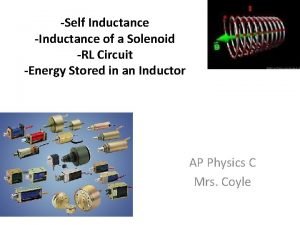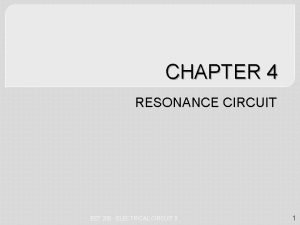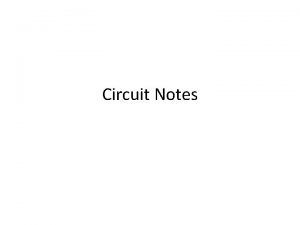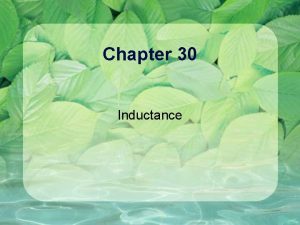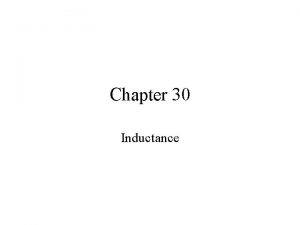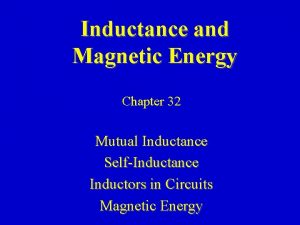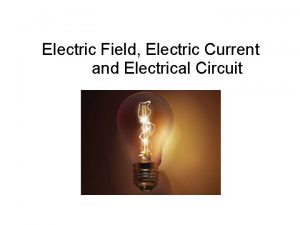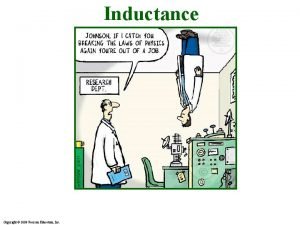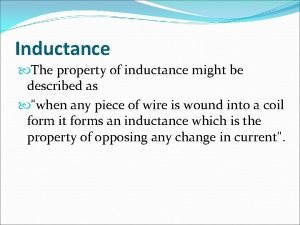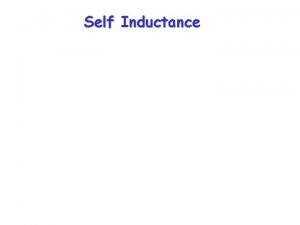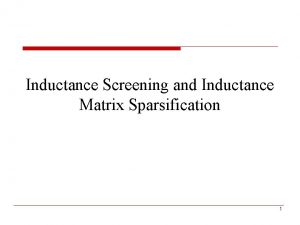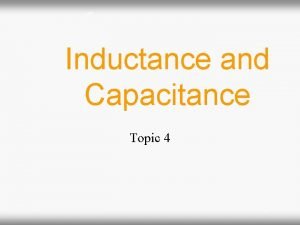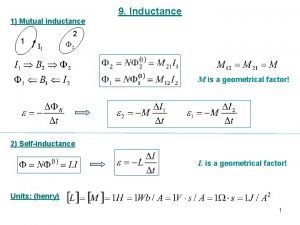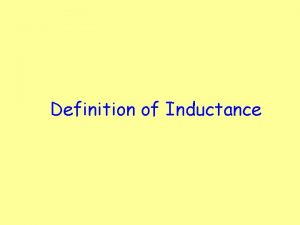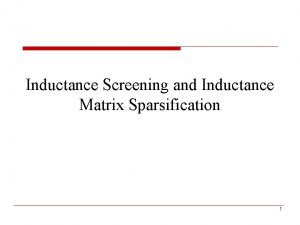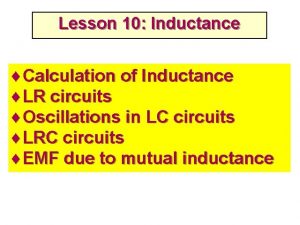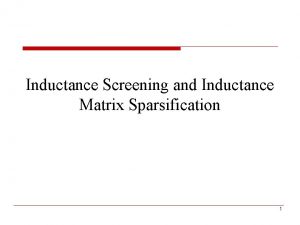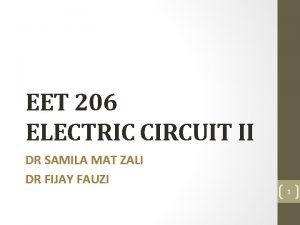ELECTRIC CIRCUIT 2 EET 141 Chapter 1 INDUCTANCE















































- Slides: 47

ELECTRIC CIRCUIT 2 EET 141 (Chapter 1) INDUCTANCE & CAPACITANCE

INDUCTANCE • Characteristic of inductor • Relationship between voltage, current, power, and energy for inductance • Series parallel combinations for inductance

Inductors • An inductor is a passive two terminal electrical component designed to store energy in its magnetic field. • A practical inductor is usually formed into a cylindrical coil with many turns of conducting wire. 3

Inductors • Inductance, L is the property whereby an inductor exhibits opposition to the change of current flowing through it, measured in henrys (H). • The unit of inductors is Henry (H), m. H (10– 3) and H (10– 6). • Inductance of an inductor depends on its physical dimension and construction. 4

Inductance Inductance, L L = inductance in henrys (H). N = number of turns µ = core permeability A = cross-sectional area (m 2) ℓ = length (m) • µ depends on the material of core. The core may be made of iron, steel 5 or plastic

Inductance can be increased by • increasing the number of turns of coil • using material with higher permeability as the core • increasing the cross-sectional area • reducing the length of coil 6

Relationship between voltage, current, power and energy Inductor Symbol Inductor Voltage 7

Inductor current i(t 0) is total current for Power 8

• Assuming that energy is zero at time t= , then inductor energy is: 9

An inductor: ØActs like a short circuit to dc ØThe current through an inductor cannot change instantaneously Ø Voltage across an inductor can change abruptly ØAn ideal inductor does not dissipate energy Ø Practically, non-ideal inductor has significant resistive components so it will dissipate energy 10

Example 1 The terminal voltage of a 2 -H inductor is v = 10(1 -t) V. Find the current flowing through it at t = 4 s and the energy stored in it within 0 < t < 4 s. Assume i(0) = 2 A. Answer: i(4 s) = -18 A w(4 s) = 320 J 11

v = 10(1 -t) V, L=2 H 0 < t < 4 s. Assume i(0) = 2 A 12

v = 10(1 -t) V, L=2 H 0 < t < 4 s. Assume i(0) = 2 A 13

Exercise 1 Determine the current through a 10 H inductor if the voltage across it is. Also find the energy stored at t=3 s. Assume i(0)=0. Ans: i(t) = 0. 3 t 3+2 t A W = 994. 05 J

Example 2 If the current through a 1 m. H inductor is i(t)=20 cos (100 t) m. A, find the terminal voltage and energy stored. 15

To find terminal voltage 16

To find energy stored 17

Exercise 2 Determine the current through 3 m. H inductor if the voltage is Then find the energy stored. Assume i(0)=0. Ans: i(t) = 75 sin 200 t A W = 8. 4375 sin 2 200 t J

Example 3 Determine vc, i. L, and the energy stored in the capacitor and inductor in the circuit shown below under dc conditions. Answer: i. L = 3 A v. C = 3 V w. L = 1. 125 J w. C = 9 J 19

In dc, inductor act like short circuit and capacitor act like an open circuit By current divider; At circuit 20

Vc is equals to voltage at resistor 1Ω Energy stored in capacitor Energy stored in inductor 21

Exercise 3 Determine the energy stored in inductor under dc conditions. Ans: 3. 086 J, 4. 1663 J

Exercise 4 Determine the energy stored in the capacitor and inductor in the circuit shown below under dc conditions. Ans: WC 1 = 4. 564 J WC 2 = 24. 792 J WL = 23. 867 J

Series and Parallel Inductors • The equivalent inductance of series-connected inductors is the sum of the individual inductances. 24

Series and Parallel Inductors • The equivalent capacitance of parallel inductors is the reciprocal of the sum of the reciprocals of the Individual inductances. 25

Exercise 5 Calculate the equivalent inductance for the inductive ladder network in the circuit shown below: Answer: Leq = 25 m. H 26

DELTA - WYE CONFIGURATION • Delta - Wye configuration for inductor is the same as resistor

DELTA - WYE Transformation

WYE - DELTA Transformation

Exercise 6 Determine the equivalent inductance across terminal a-b Ans: 22. 405 m. H

VOLTAGE DIVIDER

CURRENT DIVIDER

SUMMARY • Current and voltage relationship for R, L, C + + + 33

Example 4 In the circuit i 1(t)=0. 6 e-2 t A. If i(0)=1. 4 A find; • (a) i 2(0) • (b) i 2(t) and i (t) • (c) v 1(t), v 2(t) and v (t) 34

(a) i 2(0) i 1(t)=0. 6 e-2 t i(0)=1. 4 A At circuit, 35

(b) i 2(t) and i (t) i 1(t)=0. 6 e-2 t 36

37

To find i (t) i 1(t)=0. 6 e-2 t From previous solution; 38

(c) v 1(t), v 2(t) and v (t) i 1(t)=0. 6 e-2 t 39

To find V 2(t) From previous solution; 40

To find V(t) From previous solution; 41

IMPORTANT NOTES! • From v =L di/dt, if current is constant, v = 0. Therefore inductor acts like a short cct to dc • Inductor opposes the change of current flowing through it. Therefore the current through inductor cannot change abruptly • Ideal inductors are assume to have zero internal resistance but non ideal (practical) inductors always have internal resistance r. L 42

PRACTICE 1 • Find Vc, i. L and energy stored in the capacitor and inductor in the circuit below under dc condition Ans: i. L= 2 A Vc=0 V WL=1 J WC= 0 J 43

PRACTICE 2 • Under steady state dc condition, find I and v Ans: i= 3 m. A V=60 V 44

PRACTICE 3 • Determine Leq at terminal a-b Ans: Leq=7. 7778 m. H 45

PRACTICE 4 • Find Leq at the terminal a-b Ans: Leq=20 m. H 46

PRACTICE 5 • Find (a) Leq, i 1(t) and i 2(t) if is= 3 e-tm. A (b) vo(t) (c) energy stored in the 20 m. H inductor at t=1 s Ans: (a) Leq=6. 6667 m. H i 1=e-tm. A i 2=2 e-tm. A (b) vo(t)= -20 e-tu. A (c) w 20 m. H= 1. 3534 n. J 47
 A suitable electric pump in an electric circuit is a
A suitable electric pump in an electric circuit is a Tow thomas filter
Tow thomas filter Circuito de antoniou
Circuito de antoniou Chapter 21 electric charge and electric field
Chapter 21 electric charge and electric field Chapter 21 electric charge and electric field
Chapter 21 electric charge and electric field Coloumb units
Coloumb units Units of a charge
Units of a charge Chapter 23 electric current circuit happenings
Chapter 23 electric current circuit happenings Energy energy
Energy energy Potential due to a dipole
Potential due to a dipole Electric potential from electric field
Electric potential from electric field Electric potential is
Electric potential is Electric charges and electric forces lesson outline
Electric charges and electric forces lesson outline Rbac 140
Rbac 140 141.ir
141.ir Cse 141
Cse 141 Cse 141
Cse 141 Berger code checker
Berger code checker Bremelanotide spray
Bremelanotide spray Art 141 cod fiscal
Art 141 cod fiscal Upn 141
Upn 141 Asc 805 business combinations
Asc 805 business combinations How many months is 141 days
How many months is 141 days Ee 141
Ee 141 D-141
D-141 Chemistry 141
Chemistry 141 Sfas 142
Sfas 142 Art 141 lgt
Art 141 lgt Ieee 141
Ieee 141 Ee 141
Ee 141 134/141
134/141 Cse 141
Cse 141 Ley 141 15
Ley 141 15 Mhu-141 munitions trailer
Mhu-141 munitions trailer Hive ap 121
Hive ap 121 Circuit electric cu 3 becuri
Circuit electric cu 3 becuri Symbols for some electric circuit components
Symbols for some electric circuit components Electric circuit definition
Electric circuit definition What is node in electrical circuit
What is node in electrical circuit Fungsi perancangan instalasi listrik rumah tangga
Fungsi perancangan instalasi listrik rumah tangga Phet electric circuits
Phet electric circuits Electric circuit analysis using laplace transform
Electric circuit analysis using laplace transform Water analogy for electricity
Water analogy for electricity Analogy between electric and magnetic circuit
Analogy between electric and magnetic circuit Electric current in series circuit
Electric current in series circuit Principle of electric circuit
Principle of electric circuit Electric circuit elements
Electric circuit elements What is an electric circuit class 7
What is an electric circuit class 7

